CHEVROLET BLAZER 1993 Owners Manual
Manufacturer: CHEVROLET, Model Year: 1993, Model line: BLAZER, Model: CHEVROLET BLAZER 1993Pages: 386, PDF Size: 20.7 MB
Page 271 of 386
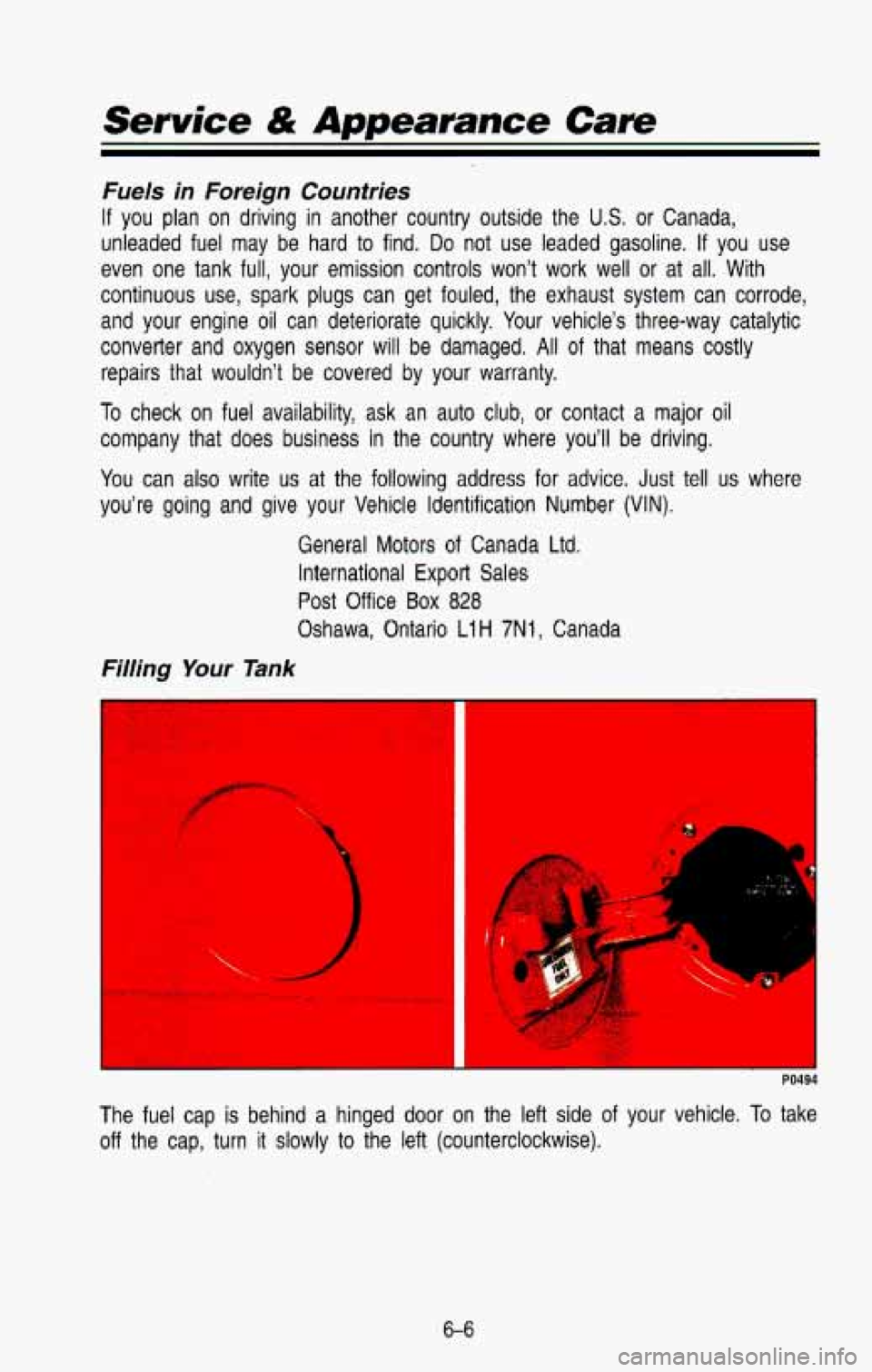
Service & Appearance Care
Fuels in Foreign Countries
If you plan on driving in another country outside the US. or Canada,
unleaded fuel may be hard
to find. Do not use leaded gasoline. If you use
even one tank full, your emission controls won’t work well \
or at all. With
continuous use, spark plugs can get fouled, the exhaust system \
can corrode,
and your engine
oil can deteriorate quickly. Your vehicle’s three-way catalytic
converter and oxygen sensor will be damaged.
All of that means costly
repairs that wouldn’t
be covered by your warranty.
To check on fuel availability, ask an auto club, or contact a major oil
company
that does business in the country where you’ll be driving.
You can also write us at the following address for advice. Just tell us where
you’re
going and give your Vehicle Identification Number (VIN).
General Motors of Canada Ltd.
International Export Sales
Post Office Box 828
Oshawa, Ontario L1H 7N1, Canada
Fi/ling Your Tank
I PO444
The fuel cap is behind a hinged door on the left side of your vehicle. To take
off the cap, turn it slowly to the left (counterclockwise).
6-6
Page 272 of 386
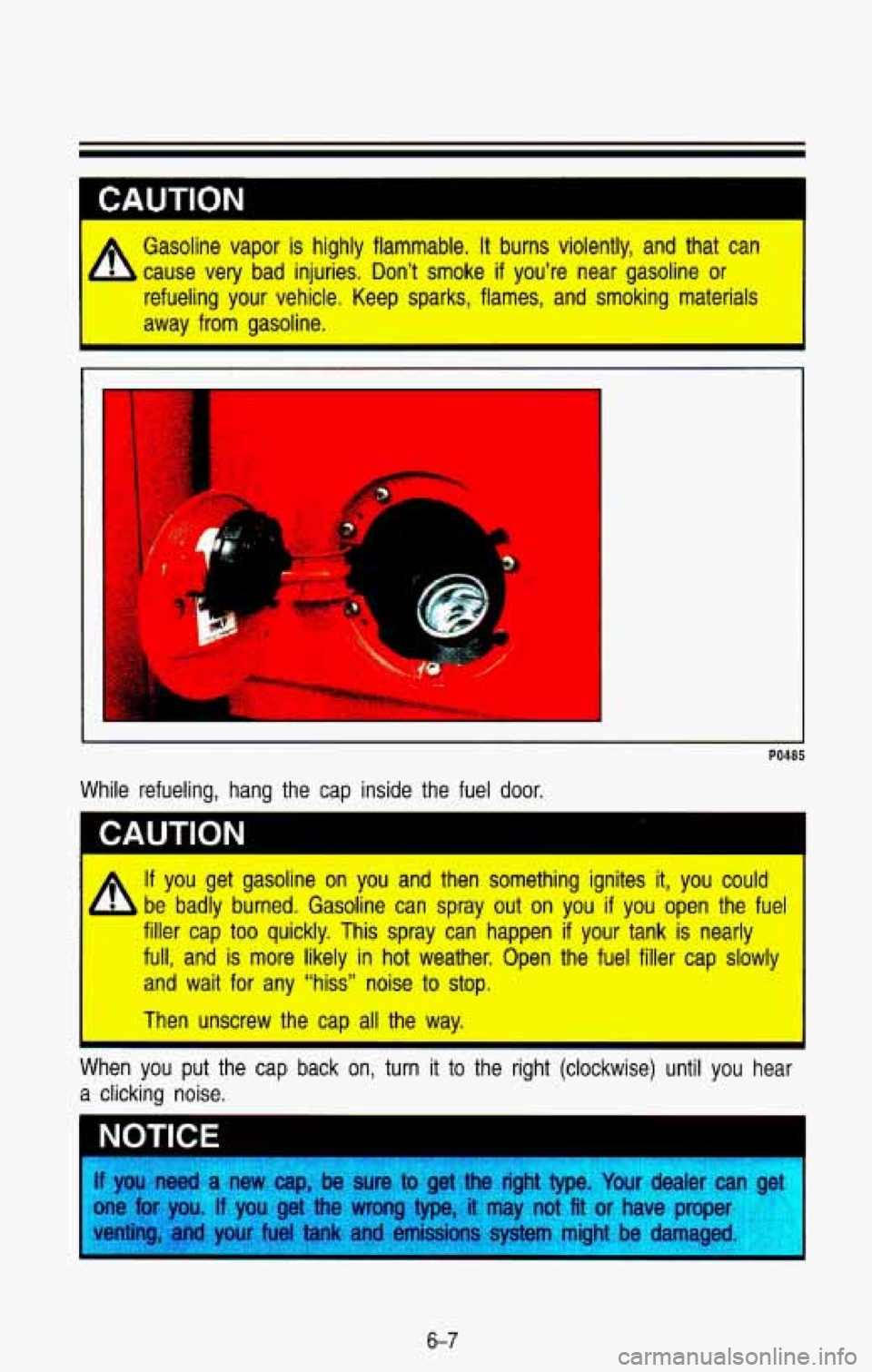
A
Gasoline vapor is highly flammable. It burns violently, and that can
cause very bad injuries. Don’t smoke
if you’re near gasoline or
refueling your vehicle. Keep sparks, flames, and smoking materia\
ls
away from gasoline.
I.
c
PO485
A
If you get gasoline on you and then something ignites it, you\
could
be badly burned. Gasoline can spray out on you
if you open the fuel
filler cap too quickly. This spray can happen
if your tank is nearly
full, and
is more likely in hot weather. Open the fuel filler cap slowly
and wait
for any “hiss” noise to stop.
I Then unscrew the cap all the way.
When you put the cap back on, turn it to the right (clockwise) until you hear
a clicking noise.
I NOTICE
r
6-7
Page 273 of 386
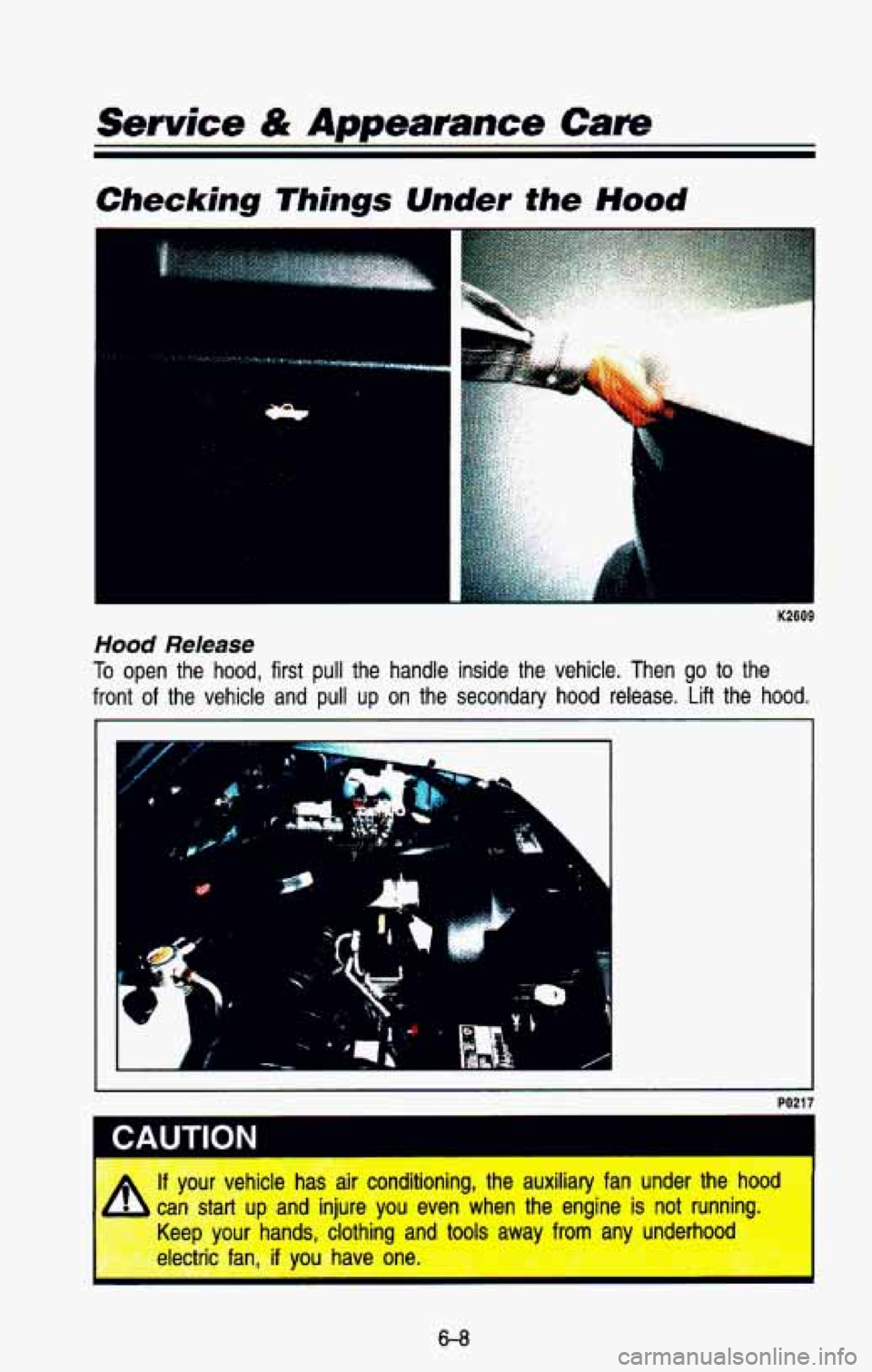
Service & Appearance Care
Checking Things Under the Hood
a&
.. .. .
~
Hood Release
To open the hood, first pull the handle inside the vehicle. Then go to the
front of the vehicle and pull
up on the secondary hood release. Lift the hood.
PO21 7
.. .
CAUTION
A
If your vehicle h;- air conditioning, the auxiliary fan under the hood
,can
start up and injure you even when the engine is not runninc
*y,?*& 8gKeep your hands, clothing and tools awav from anv underhoo
Wk%selectric fan,
you have one
6-8
Page 274 of 386
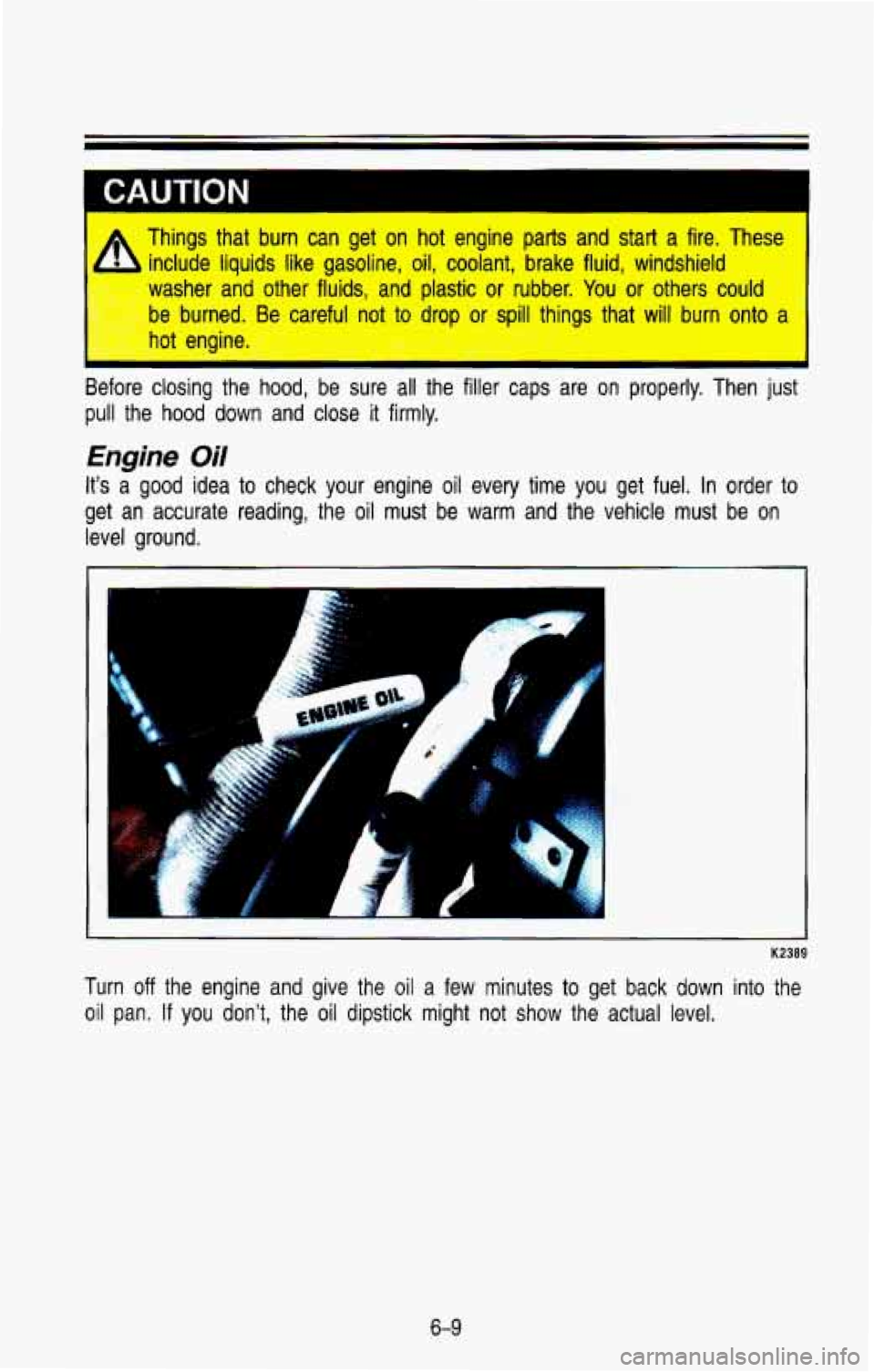
~AUTION
- Things that burn can get on hot engine parts and start a fire. These
include liquids like gasoline,
oil, coolant, brake fluid, windshield
washer and other fluids, and plastic or rubber.
You or others could
be burned. Be careful not to drop or spill things that will burn onto a
Before closing the hood, be sure
all the filler caps are on properly. Then just
pull the
hood down and close it firmly.
Engine Oil
It's a good idea to check your engine oil every time you get fuel. In order to
get an accurate reading, the
oil must be warm and the vehicle must be on
level ground.
Turn
off the engine and give the oil a few minutes to get back down into the
oil pan. If you don't, the oil dipstick might not show the actual level.
6-9
Page 275 of 386
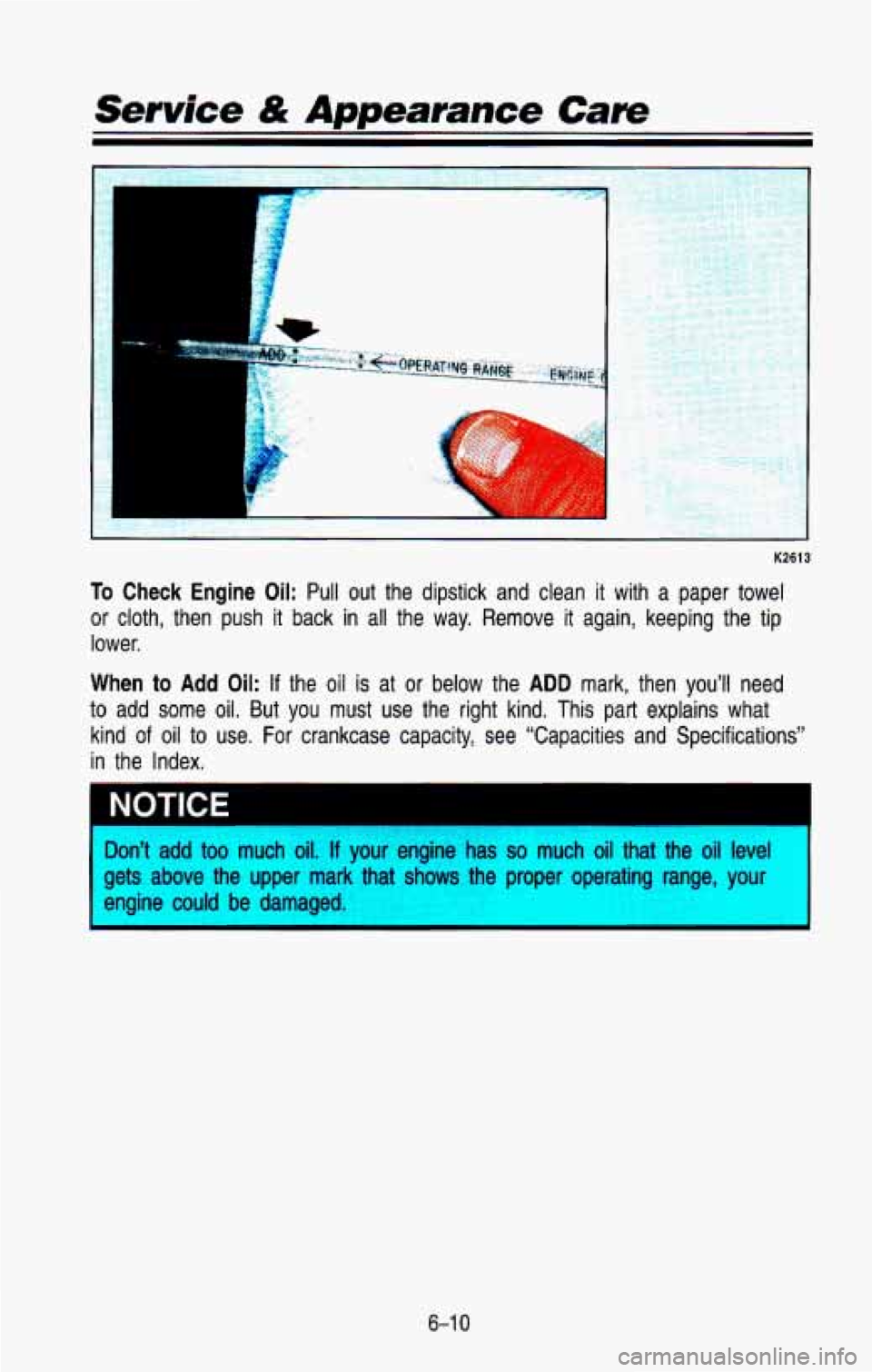
I
K2613
To Check Engine Oil: Pull out the dipstick and clean it with a paper towel
or cloth, then push
it back in all the way. Remove it again, keeping the tip
lower.
When to Add Oil: If the oil is at or below the ADD mark, then you’ll need
to add some oil. But you must use the right kind. This part exp\
lains what
kind
of oil to use. For crankcase capacity, see “Capacities and Specification\
s”
in the Index.
I Don’t add too much oil. If your engine has so much oil that the oil level
gets above the upper mark that
shows the proper operating range, your
engine could be damaged.
I
6-1 0
Page 276 of 386
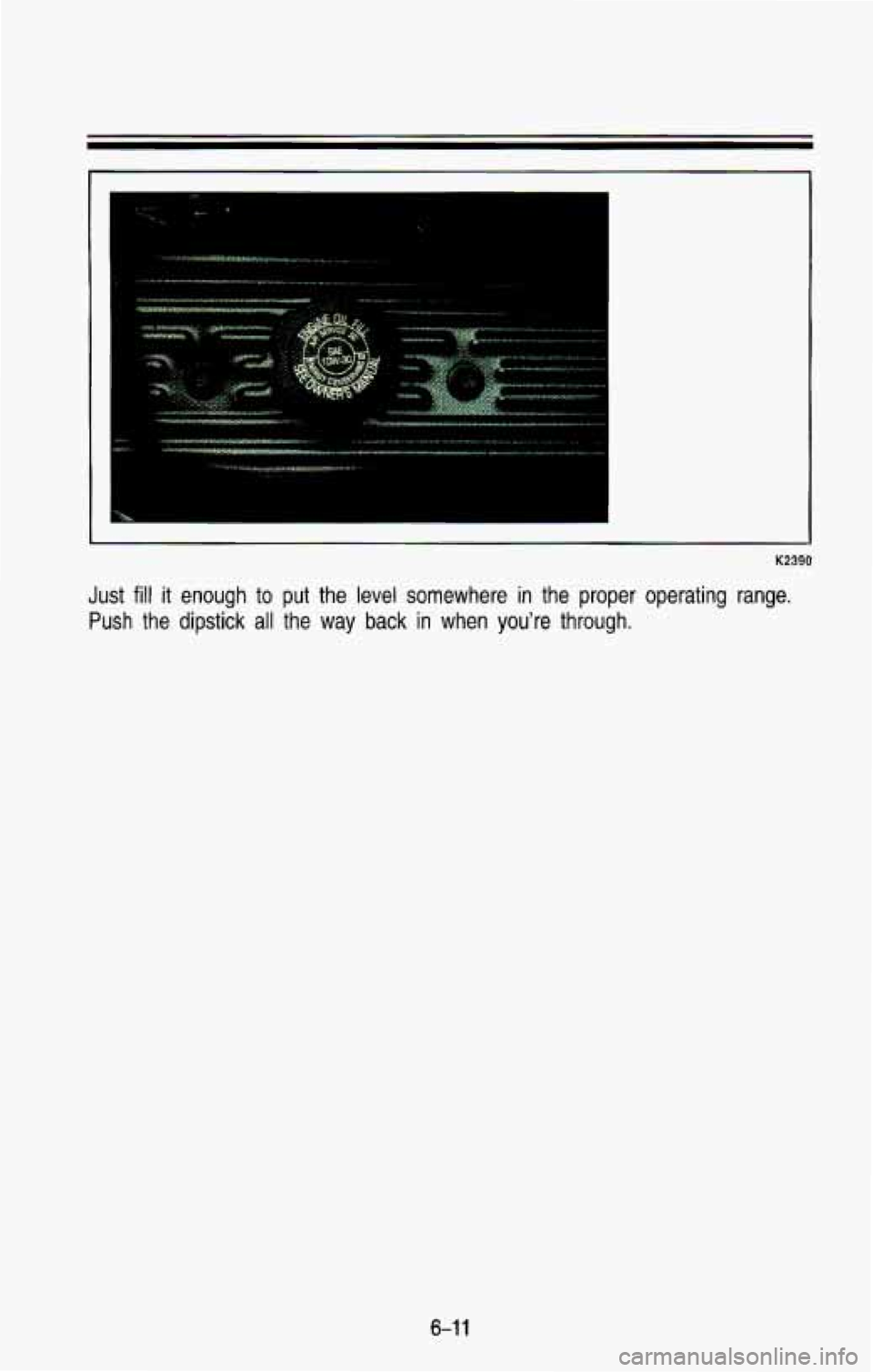
K2390
Just fill it enough to put the level somewhere in the proper operating range.
Push the dipstick all the way back in when you’re through.
6-1 1
Page 277 of 386
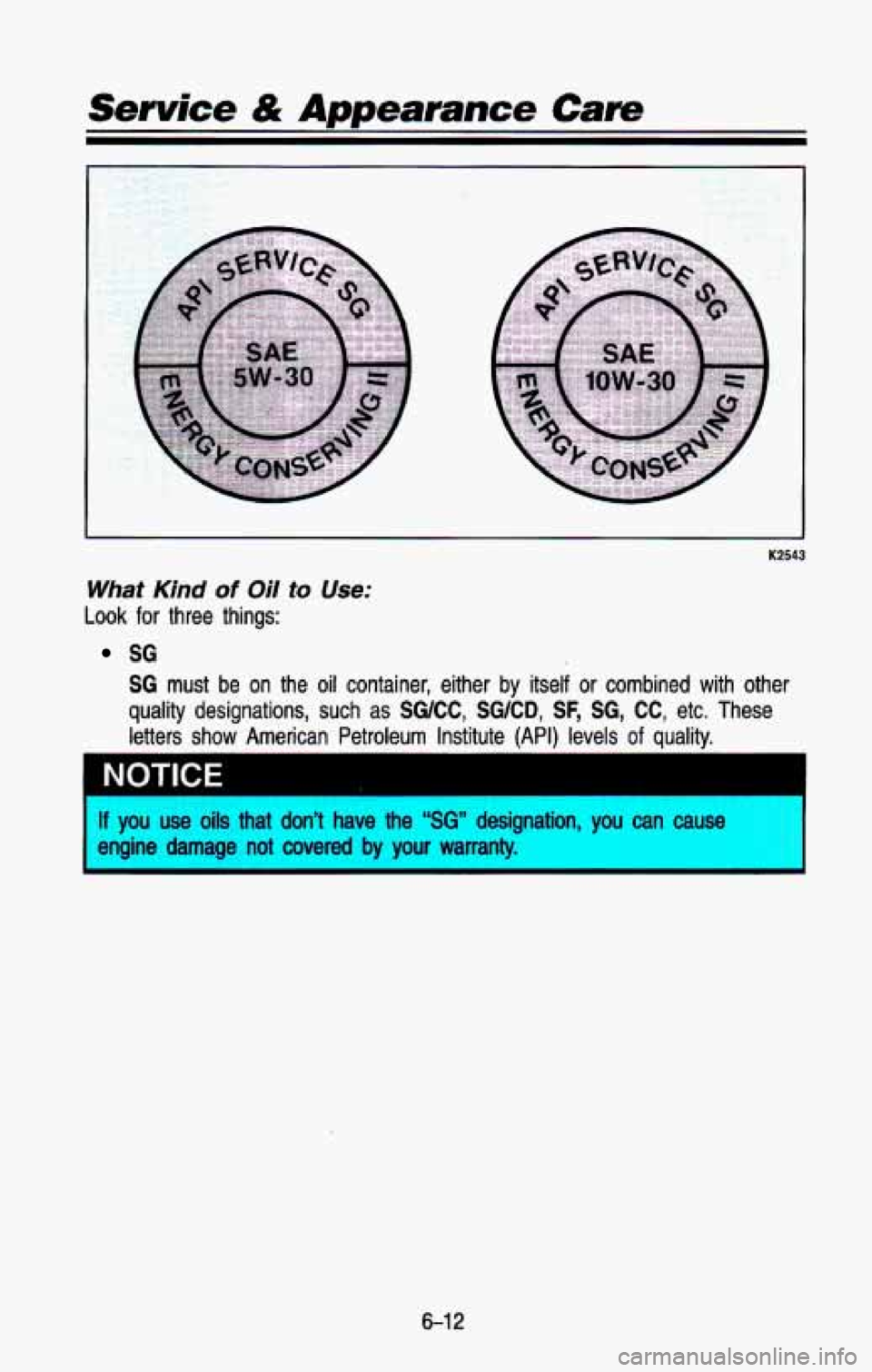
Service & Appearance Cam
r
K2543
What Kind of Oil to Use:
Look for three things:
SG
SG must be on the oil container, either by itself or combined with other
quality designations, such as WCC, SG/CD, SF, SG, CC, etc. These
letters show American Petroleum Institute (API) levels
of quality.
I NOTICE
f you use oils that don’t have the “SG” designa..-.., , - J can cause
mgine damage not covered by your warranty.
6-1 2
Page 278 of 386
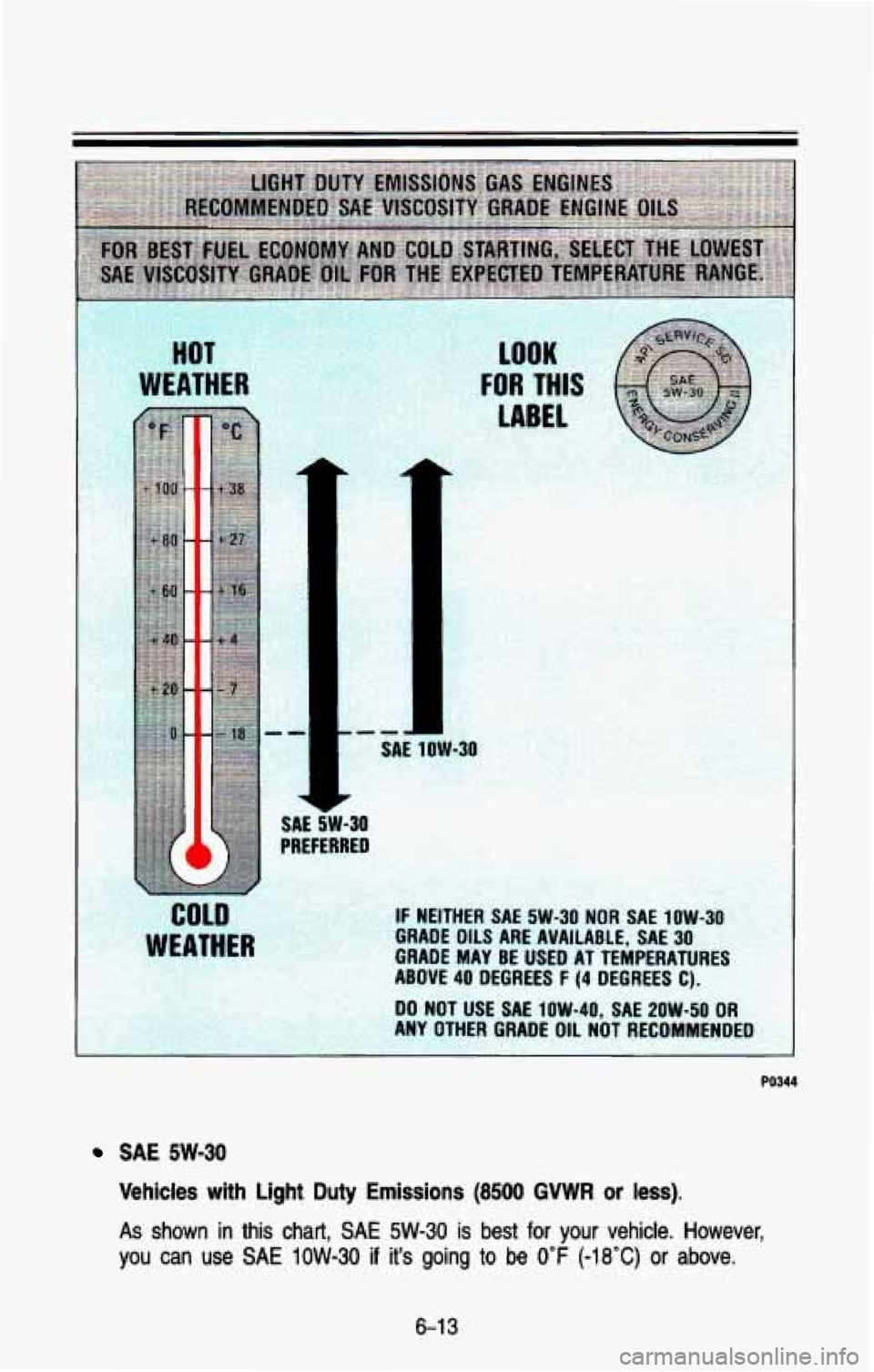
SAE 5W-30
Vehicles with Light Duty Emissions (8500 GVWR or less).
As shown in this chart, SA€ 5W-30 is best for your vehicle. However,
you can use SAE 1OW-30 if it's going to be 0°F (-18°C) or above.
6-1 3
Page 279 of 386
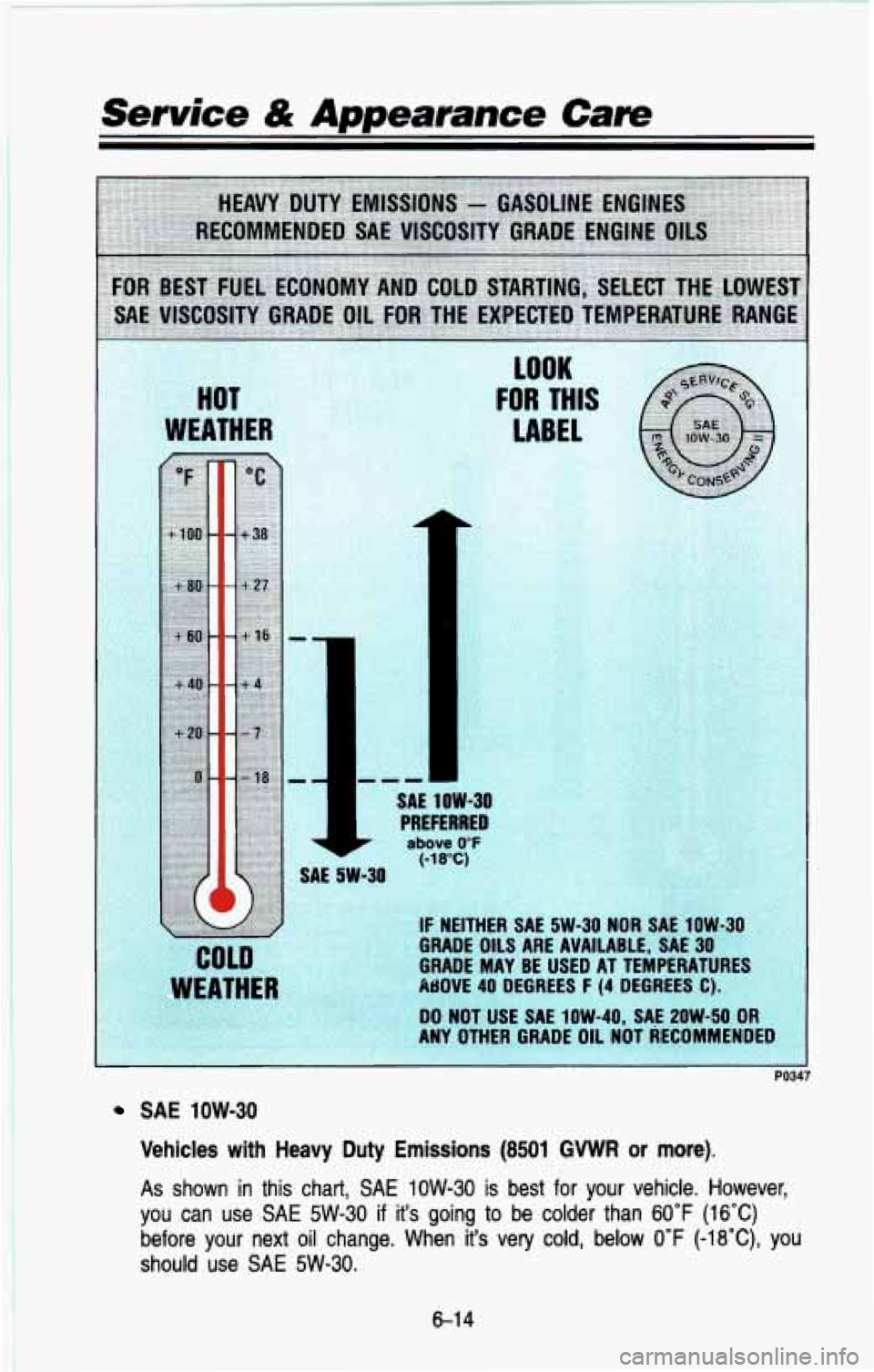
Service & Appearance Care
SAE IOW-30
Vehicles with Heavy Duty Emissions (8501 GWR or more).
As shown in this chart, SAE 1OW-30 is best for your vehicle. However,
you can use
SAE 5W-30 if it's going to be colder than 60°F (16°C)
before your next oil change. When it's very cold, below 0°F (-18"C), you
should use
SAE 5W-30.
6-14
Page 280 of 386
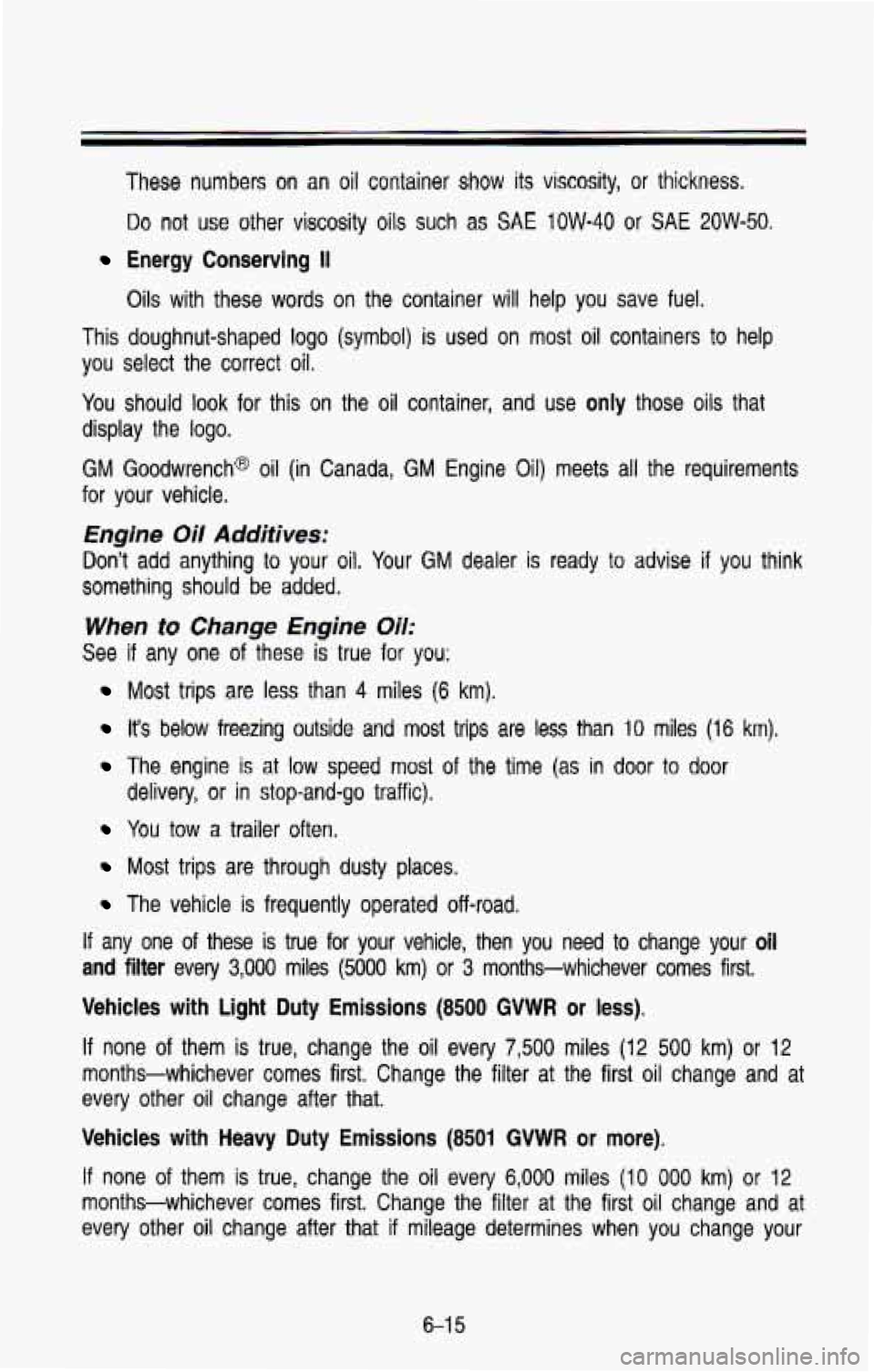
These numbers on an oil container show its viscosity, or thickness.
Do not use other viscosity oils such as SAE 1OW-40 or SAE 2OW-50.
Energy Conserving II
Oils with these words on the container will help you save fuel.
This doughnut-shaped logo (symbol) is used on most oil contai\
ners to help
you select the correct oil,
You should look for this on the
oil container, and use only those oils that
display the logo.
GM Goodwrench@ oil (in Canada, GM Engine Oil) meets all the requirements
for your vehicle.
Engine Oil Addifives:
Don't add anything to your oil. Your GM dealer is ready to advise if you think
something should be added.
When to Change Engine Oil:
See if any one of these is true for you;
Most trips are less than 4 miles (6 km).
It's below freezing outside and most trips are less than 10 miles (16 km).
The engine is at low speed most of the time (as in door to door
You tow a trailer often.
Most trips are through dusty places.
The vehicle is frequently operated off-road. delivery, or in stop-and-go
traffic),
If any one of these is true for your vehicle, then you need to change your oil
and filter every 3,000 miles (5000 km) or 3 months-whichever comes first.
Vehicles with Light Duty Emissions (8500 GVWR or less).
If none of them is true, change the oil every 7,500 miles (1 2 500 km) or 12
months-whichever comes first. Change the filter at the first oil change and at
every other oil change after that.
Vehicles with Heavy Duty Emissions (8501 GVWR or more).
If none of them is true, change the oil every 6,000 miles (1 0 000 km) or 12
months-whichever comes first. Change the filter at the first oil change and at
every other oil change after that if mileage determines when you change your
6-1 5